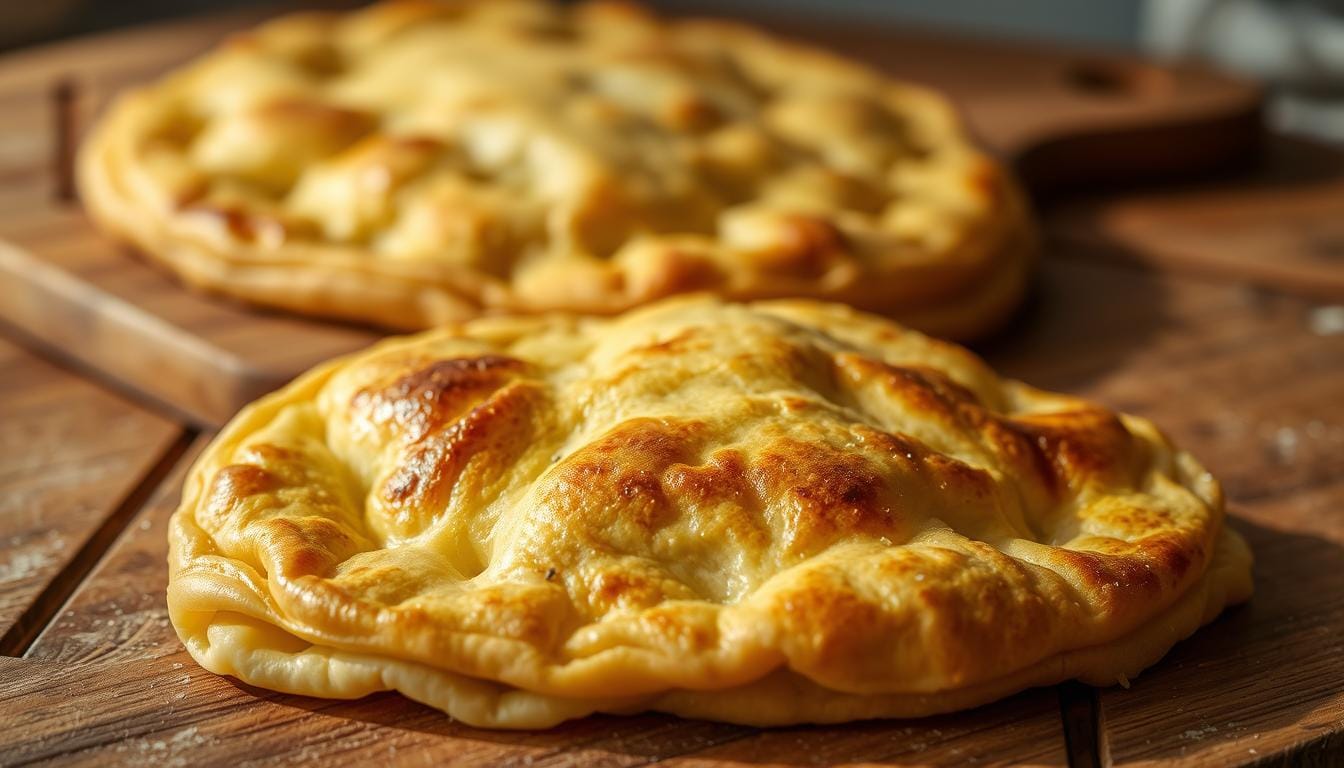Imagine walking into a warm kitchen. The air is filled with the smell of freshly baked bread. It’s a comfort that takes you back to Morocco’s busy streets.
As you see the layers of msemen, you feel a deep connection. This flaky flatbread is more than food. It’s a celebration of Moroccan cuisine’s rich history. In this guide, you’ll learn how to make msemen. You’ll also discover how to get its crispy outside and soft inside.
Table of Contents
Key Takeaways
- Msemen is a traditional Moroccan flatbread known for its flaky, layered structure.
- It can be enjoyed at any time of day, whether for breakfast, as a snack, or with savory dishes.
- The method of layering dough and fat is vital for achieving its unique texture.
- This versatile dish lends itself to various serving options, enriching Moroccan cuisine.
- Making msemen at home connects you with a rich culinary heritage and allows for creative adaptations.
Introduction to Msemen
Msemen is a traditional Moroccan flatbread loved by many around the world. It’s a key part of Moroccan breakfasts and also great as a snack or appetizer. Its flaky layers and buttery taste make it a joy to eat.
With an easy msemen recipe, you can make this delicious flatbread at home. It’s perfect on its own or with different fillings. You can try sweet or savory toppings, making it versatile.
In a Moroccan breakfast, msemen goes well with honey, cheese, or olives. It’s a true reflection of Moroccan culture. Trying msemen is a great way to explore new flavors.
What is Msemen?
Msemen is a tasty flatbread that’s a big part of Moroccan cuisine. It’s known as Moroccan pancakes because of its flaky layers. The dough is made from flour, semolina, yeast, and water.
When you mix in melted butter and olive oil, it gets even better. These ingredients make the dough flaky. Cooking it on a hot pan makes it golden and crispy.

| Characteristics of Msemen | Description |
|---|---|
| Texture | Crispy exterior with soft, flaky layers |
| Color | Golden brown |
| Flavor | Rich and buttery, thanks to the added fats |
| Versatility | Can be served with savory or sweet toppings |
Msemen (Layered Moroccan Flatbread) Origin and Cultural Significance
Msemen’s story is a mix of Morocco’s diverse food traditions. This layered flatbread is a symbol of warmth, hospitality, and family gatherings. It’s a key part of Moroccan cuisine, enjoyed during special times.
Msemen is more than just a tasty treat. It’s a staple at breakfast, showing food’s role in daily life. You can pair it with sweet honey or savory dips, making each bite unique.
Msemen shows the heart of Morocco’s culture and food heritage. Sharing meals strengthens bonds and values community and kindness. It offers a glimpse into the lively culture of Morocco.
Ingredients You Need for Homemade Msemen
To make homemade msemen, knowing the right ingredients is key. Each part adds to the taste and texture of the dish. Here’s what you’ll need for this tasty treat.
Key Ingredients and Their Roles
- All-Purpose Flour: It’s the dough’s base, giving it structure.
- Fine Semolina: It makes the flatbread crispy.
- Salt: It boosts the flavor of your msemen.
- Yeast: It lets the dough rise, making it light and airy.
- Baking Powder: It adds extra lift for fluffiness.
- Warm Water: It hydrates the dough to the right consistency.
- Melted Butter and Olive Oil: They’re used for layering and add richness.
Alternative Ingredients for Dietary Preferences
If you follow certain diets, there are alternatives for msemen. For gluten-free, use gluten-free flour mixes. Swap olive oil and butter with coconut or avocado oil for a dairy-free version. Try whole wheat flour for different textures and tastes.

Step-by-Step Guide to Making Msemen
Making msemen is easy with a few key steps. This guide will help you learn each step. You’ll go from making the dough to cooking it to perfection.
Preparing the Dough for Msemen
Start by mixing flour, semolina, salt, and baking powder in a big bowl. Mix in warm water with yeast. Then, add more warm water while kneading for 10-15 minutes.
This makes the dough smooth. Cover it with a damp cloth for 30 minutes. This helps it become easier to work with.
Techniques for Achieving Flaky Layers
To get flaky msemen, divide the dough into small balls. Coat each ball with melted butter or oil. Roll them out thinly.
Fold the dough in on itself several times. Then, roll it out again. This creates the flaky layers you want.
Cooking Methods to Perfect Your Msemen
Heat a non-stick pan over medium heat. Place the msemen squares in the pan. Cook each side for 2-3 minutes, until golden.
Brush with butter or oil for extra crispiness. Keep the heat right to keep the msemen moist on the inside. Now, you can enjoy your homemade msemen!

Creative Ways to Serve Msemen
Msemen is a versatile dish that can be served in many ways. For a sweet twist, try drizzling honey over warm msemen or add fruit jams. These ideas not only boost the flavor but also make the dish look vibrant.
For a savory option, msemen goes great with tagines or fresh salads. These pairings make for a well-rounded meal. By trying different ways to serve msemen, you can make it the star of any meal.
Don’t be afraid to get creative with toppings or fillings. You could use herbs, spiced meats, or cheeses. This lets you create unique meals every time. Serving msemen is all about exploring different flavors, making it a joy to share at any meal.
| Serving Style | Description |
|---|---|
| Sweet with Honey | Drizzle honey over warm msemen for a luscious treat. |
| Fruit Jam Pairing | Serve msemen with assorted fruit jams for a colorful spread. |
| Tagine Accompaniment | Pair msemen with rich tagines to enhance the meal. |
| Salad Pairing | Enjoy msemen alongside fresh salads for a balanced dish. |
| Herbed and Spiced Fillings | Create variations by adding herbs or spiced meats. |
Variations of Msemen in Moroccan Cuisine
Msemen is more than just a dish; it’s a world of flavors. Its many variations show how versatile this flatbread is. Sweet and savory msemen are two main styles, each bringing a unique taste to the table.
Sweet Msemen: A Delightful Twist
Sweet msemen is a treat for those who love sweet things. You can make it by adding sugar or honey to the dough. Another way is to fill it with almonds and sugar, creating a flaky dessert.
This dessert is perfect with a warm cup of mint tea. It’s a delightful snack or dessert.
Savory Msemen: Perfect Pairings with Tagines
Savory msemen adds depth to your meals. It’s filled with minced meat, veggies, or spices. It pairs well with Moroccan tagines, soaking up their rich sauces.
This combo is not just tasty but also satisfying. It truly shows off Moroccan cuisine’s flavors.
Tips for Storing and Reheating Msemen
To keep your msemen fresh, it’s important to store and reheat them right. For a short time, put them in an airtight container at room temperature for up to two days. If you need to keep them longer, the fridge is a good choice. For even longer storage, freezing is best.
Before freezing, wrap each msemen in plastic wrap. Then, put them in a freezer-safe bag to avoid freezer burn.
When you’re ready to eat your msemen again, reheating is key. Use a skillet over low heat to restore their crispy layers. You can also reheat them in a low-temperature oven. But, avoid microwaving to prevent them from becoming chewy and losing their crispiness.
Conclusion
Learning to make msemen adds to your cooking skills and connects you to Moroccan culture. This flaky, buttery flatbread is more than food; it’s a way to bring people together. It’s a tradition passed down through generations.
Msemen can be enjoyed at any time, from breakfast to dinner. It’s a versatile dish that you can make your own. You can add flavors that your family loves.
Start making msemen today. It’s not just delicious; it’s a way to honor Moroccan heritage. Every bite is a celebration of tradition.

